 NCDC / Climate Monitoring / 2003 / Latest Monthly Report / Wildfires / Search / Help NCDC / Climate Monitoring / 2003 / Latest Monthly Report / Wildfires / Search / Help
Use these links to access detailed analyses of Global and U.S. data. 

|
| The Western wildfire season began slowly in 2003 due to some late winter precipitation at the lower elevations, however a persistent ridge of high pressure dominated the western weather pattern for much of the season leading to hotter and drier than average conditions in much of the West. Many states and cities had their hottest summers on record in parts of the West. Fire activity escalated in May in the Southwest continuing well into July. One of the largest fires in the Southwest in 2003 was the Aspen fire near Tucson, Arizona, which burned around 85,000 acres in June and July, according to the National Interagency Fire Center. |
|
|
In late July, fire activity increased in the Northern Rockies with large areas in western Montana and southern Idaho threatened, including areas of Glacier National Park. The fires in the northern Rockies were not completely contained until mid September with fire suppression personnel being drafted from many areas of the country. More than 20,000 firefighters and support personnel were assigned at the peak of activity. Over 700,000 acres were burned and 96 structures destroyed in the Northern Rockies in the 2003 wildfire season.
Santa Ana wind-driven fire activity developed in California in October. Over 750,000 acres were destroyed in 15 large fires in southern California. Over 3,500 homes were also burned and over 1,100 other buildings comsumed in the California fires. According to the National Interagency Fire Center, at the end of November, the national number of fires were reported at 74% and the acres burned were at 81% of the ten-year average. |

 October
October
| SPECIAL FEATURE:
California Fires in October Large wildfires broke out in southern California and especially San Bernardino County and just east of San Diego during late October 2003. Numerous fatalities and over 3500 structures were destroyed in the fires, several of which continued to burn at the end of the month. Dry conditions, Santa Ana winds and large amounts of available fuel (eg. dead and dormant vegetation) combined to destroy over half a million acres in this outbreak. Conditions that assisted firefighters, including higher humidity, cooler temperatures and some rain occurred during the first couple of days of November. More satellite images of the fires. The largest fire since 1932 in California, the Cedar Fire in San Diego County, was part of this outbreak and alone, consumed over 250,000 acres. |
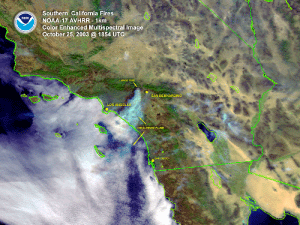 click for animation of satellite imagery |
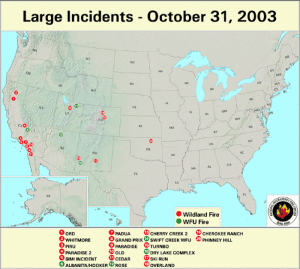 larger image |
|

 September
September
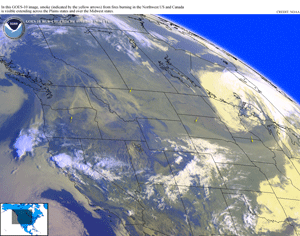 larger image |
During September, wildfire activity decreased sharply across the western U.S. In particular, fire activity diminished across the Northern Rockies during the first half of September, where numerous large fires had been burning at the beginning of the month. Early in September, large fires across the Northwest and Northern Rockies generated a significant smoke pall, which was visible by satellite imagery moving east into the Midwest. By the end of the month, year-to-date wildfire activity remained below the ten-year average for the number of fires and acres burned (see table below). As of September 30th across the western U.S., the Northern Rockies region had the largest number of acres burned for the season (908,464 acres), followed by Alaska (574,723 acres), the Northwest Region (387,549 acres), the Eastern Great Basin Region (349,932 acres), the Southwest Region (264,491 acres), and Northern California (123,179 acres). At the end of September, Northern California was the primary focus of large fire activity in the nation, where several large fires were still actively burning. |
|
Seasonal (January 1-September 30th) wildfire statistics, according to the National Interagency Fire Center are in the table to the right.
|
|

 August
August
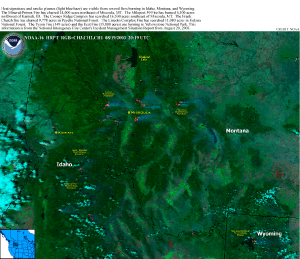 larger image |
During the first half of August, and especially in the middle third of the month, wildfire activity increased in parts of the northern Rockies. Especially hard hit was the Missoula, Montana area where some evacuations were necessary. In Montana, on August 21st there were 25 large fires burning, 7 of which had already scorched over 20,000 acres apiece. Two of those fires had burned over 40,000 acres each. Over 340,000 acres have burned in Montana as of August 21st. Large fires were also burning in Idaho and Wyoming. At the end of the month, the northern Rockies were still the focus of fire activity in the nation. |
|
Seasonal (January 1-September 1st) wildfire statistics, according to the National Interagency Fire Center are in the table to the right.
|
|

 July
July
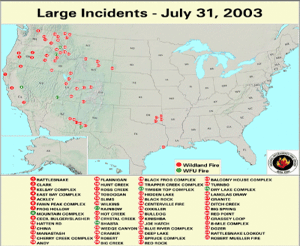 larger image |
Dry and warm conditions were conducive to fire activity throughout much of the West during July. However, the number of acres burned through the end of the month was far less than in 2002. Montana, Washington and Idaho all had large fires in July 2003. The Glacier fire forced the closure of parts of Glacier National Park to visitors for part of the month. |
| One the major fires in early July was the Aspen fire in Coronado National Forest in Arizona. Well over 84,000 acres were burned in that fire alone. Pre-instrumental evidence in the Southwest provides hundreds of years of fire scar evidence for the region. By gaining a multi-century perspective, one clear conclusion is that since 1900, fires have been less extensive mostly due to fire suppression strategies. |
Seasonal (January 1-August 3) wildfire statistics, according to the National Interagency Fire Center:
|

 June
June
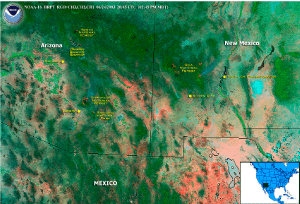 larger image |
June saw a sharp increase in wildfire activity in the western half of the U.S. in 2003. Close to a million acres of land had been burned as of the first week of July, though this is well below the 10-year average of over 1.6 million acres by the same date. Although parts of the West saw drought improvement in spring 2003 there is still persistent dryness in many areas and fire danger is high to extreme in Alaska, Arizona, California, Colorado, Hawaii, Idaho, Montana, Nevada, New Mexico, Oklahoma, Oregon, Texas, Utah, and Wyoming according to the National Interagency Fire Center. |
| One the major fires in June was the Aspen Fire in Arizona. Over 83,000 acres burned as of July 9 in the Coronado National Forest about 17 miles north of Tucson, Arizona (see image above). Other large fires have occurred in Utah, Washington and Oregon with numerous other smaller and/or newer fires burning in many western states. |
Seasonal (January 1-July 9) wildfire statistics, according to the National Interagency Fire Center:
|

 Pre-Season
Pre-Season
Several large wildfires occurred in the Great Lakes region this spring due to dryer than normal winter conditions. The lack of spring rain and snow left herbaceous vegetation vulnerable to fire (NIFC).
A brush fire in Florida on April 11th burned around 500 acres causing traffic disruption.
In Dare County, North Carolina, at least 2840 acres had been burned as of Tuesday May 13th and the fire was not yet under control. The fire started on a bombing range and very quickly spread engaging at least five firefighting departments from around the area.
Prolonged drought in many western states may contribute to an above average wildfire season in parts of the U.S, though it is not expected to be as severe as 2002 according to the National Interagency Fire Center.

 Questions?
Questions?
For all climate questions other than questions concerning this report, please contact the National Climatic Data Center's Climate Services Division:
| Climate Services Division NOAA/National Climatic Data Center 151 Patton Avenue Asheville, NC 28801-5001 fax: 828-271-4876 phone: 828-271-4800 email: questions@ncdc.noaa.gov |
For further information on the historical climate perspective presented in this report, contact:
|
Jay Lawrimore NOAA/National Climatic Data Center 151 Patton Avenue Asheville, NC 28801-5001 fax: 828-271-4328 email: Jay.Lawrimore@noaa.gov |
 NCDC / Climate Monitoring / Climate of 2003 / Latest Monthly Report / Wildfires / Search / Help
NCDC / Climate Monitoring / Climate of 2003 / Latest Monthly Report / Wildfires / Search / Help
http://www.ncdc.noaa.gov/oa/climate/research/2003/fire03.html
Downloaded Wednesday, 24-Sep-2008 19:40:19 EDT
Last Updated Friday, 18-Nov-2005 14:11:55 EST by Anne.Waple@noaa.gov
Please see the NCDC Contact Page if you have questions or comments.

